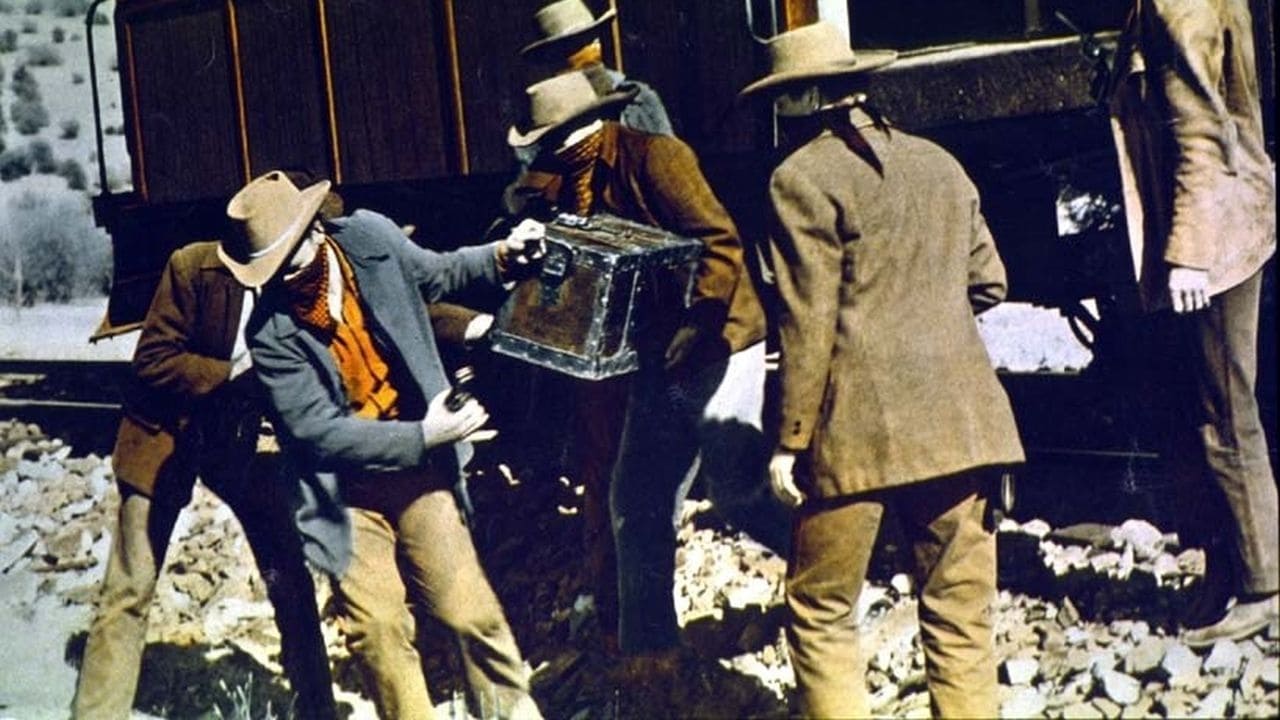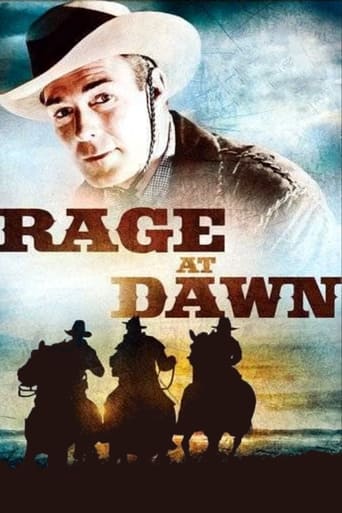Tacticalin
An absolute waste of money
2freensel
I saw this movie before reading any reviews, and I thought it was very funny. I was very surprised to see the overwhelmingly negative reviews this film received from critics.
Ketrivie
It isn't all that great, actually. Really cheesy and very predicable of how certain scenes are gonna turn play out. However, I guess that's the charm of it all, because I would consider this one of my guilty pleasures.
Myron Clemons
A film of deceptively outspoken contemporary relevance, this is cinema at its most alert, alarming and alive.
weezeralfalfa
I quote from the message on the screen at the beginning of the film "This is the true story of the Reno Brothers.....who were the first train robbers in American history". Well, the film then begins with the Reno gang being shot up attempting to rob a bank, with brother Bill killed. I could find no evidence that this gang ever attempted to rob a bank, and no Reno brother was ever shot dead! Sister Laura is presented as a refined young woman who disapproves of her brother's criminal activities, but continues to harbor them out of filial loyalty. Well, the real Laura Reno was a mid-teen wild child at this time, who supported her brother's activities, whatever they might be. But, we couldn't have 57 year old Randolph Scott wooing an under-aged wild girl! Next thing we know, the Pinkerton(renamed Peterson) Detective Agency selects Scott's character(James Barlow), an ex-Confederate spy and notorious ladies man, to head a bogus train robbery near the Reno's headquarters, to attract their attention. That's right, according to the film, the Peterson(Pinkerton) Agency staged the first train robbery in US history, and the Renos became train robbers only at the urging of Scott's character, after he was accepted as one of their gang! According to the film, the Reno's one attempt to rob a train was a disaster, resulting in the capture of all by Peterson(Pinkerton) agents waiting in the express car and in the surrounding bush.Failed bank robbers and failed train robbers. That is their claim to fame? Actually, they staged two successful train robberies before being thwarted by Pinkerton agents in their 3rd attempt, more or less as dramatized in the film, except that they were not wounded nor captured, as shown in the film! Two members of the gang, not the whole gang as depicted,did rob the courthouse in Gallatin, MO. John Reno was recognized, arrested and jailed long term as a result of this raid. Other gang members robbed a number of other courthouses in various upper Midwest states.The undramatic truth is that the other Reno brothers were captured by Pinkerton agents while hiding out in Indianapolis or in Canada.Presumably,the title of this film referes to the rage of the citizens in the regions frequented by the gang, provoking them to carry out 3 lynching incidents, not just the one shown in the film.As shown in the film, 3 Reno brothers met their fate in the last of these 3 lynching incidents, although the film got one of the brothers involved wrong. Unlike in the film, no one in these large vigilante groups was ever tried or jailed for these lynchings.The Reno brothers and their extended gang were much more versatile and successful in their criminal activities than depicted in this film, which portrays them as a poor man's prelude to the James-Younger gang. Why was this gang so reviled, whereas the James-Youngers were often hailed as heroes by locals and much better remembered today? The James Gang only robbed banks and trains, which were mostly owned by Yankee investors, and didn't much directly impact the ordinary people, mostly southern sympathizers, in the regions where the robberies took place. In contrast, the Reno brothers had a much more diverse criminal resume. They robbed various private businesses and a number of post offices and courthouses. In addition, when they used a certain hotel for their headquarters, they fleeced and sometimes murdered the guests, which increased the reputation of this region as a dangerous destination for future would be travelers. Also, they were assumed responsible for a rash of unexplained fires over a period of years, that destroyed homes and businesses. Many of these deeds hurt the locals or local government activities, rather than some far off set of investors.During the Civil War , they sometimes received bonuses for volunteering, or payment for taking the place of draft dodgers, then promptly deserted to repeat the process elsewhere, under an assumed name.The film could have illustrated some of these activities instead of a bogus failed bank robbery! It could have also spent some time exploring their childhoods for reasons for their mass criminal personalities. The Renos were hardly poverty stricken. They had substantial agricultural land holdings, which actually aided them in their criminal careers. The film does emphasize the intimidation and bribery of local law officials, which much extended their criminal careers.In summary, this oater should not be regarded, as claimed, a decent historical portrait of the Reno gang. Rather, it should be regarded as just another Scott-starring yarn, with an unusually talented set of supporting actors, exploiting the Reno gang notoriety as a reference point.Scott plays his southern gentleman persona to the hilt in dealing with the Renos and others, especially Laura. I down grade the film for claiming to be much more than what it actually delivered. It does nicely dramatize the point that vigilante justice is sometimes the only practical way to rid a community of a chronic criminal element, when the official justice system fails to do so, for various reasons.It also dramatizes the importance of the Pinkerton Agency at a time long before the FBI existed. This film is currently available very cheaply as part of a Scott Western Collection DVD package.
rlquall
This is a well-cast, well-directed, tightly-scripted film (only 87 minutes). The cast is amazing for what had to be a fairly low budget RKO picture from the mid-1950's; Randolph Scott was an established star while Forrest Tucker, J. Carrol Naish, and Denver Pyle were all established, talented Western performers and Edgar Buchanan was one of the best Western character actors of all time. What hurts the movie severely and is its major flaw is the setting. Nothing about one single shot of the film looks anything like Southern Indiana or anywhere else in the Midwest, and exactly like California, where it was actually shot. This lack of authenticity is distracting, in some scenes more than others, but never completely destroys the fine performances. Like some of the others, I would like to know more about the historical Reno Brothers and how closely this film represents their true story; I'm sure that it's somewhat closer than Elvis' ''Love Me Tender'', which is about the same topic and came out the next year.
oldsenior
First a bit of trivia: In the opening segment as the Reno Boys are riding into the Indiana Territory township for the robbery you can see an American Flag (with 48 stars I imagine) in the background with a California state flag underneath it, with it's bear in the center. The movie was shot in part in California's Columbian Historic Park in 1955..................... Anyway, I thought the movie was excellent and realistic, well told, the writing was excellent and well acted by everyone involved. What a superlative cast: Tucker was excellent, as evil as I ever saw him in any movie, Buchanan, a wonderful actor, was his sly self to perfection, as usual, Mala Powers as beautiful as usual in what I consider an unnecessary part (I wonder if this was a true part of the story), in 1955 you had to have a love interest to sell movie tickets or they supposed it to be. You also had Jimmy Lydon (Henry Aldrich), Arthur Space, Myron Healey, Kenneth Tobey, Denver Pyle, all familiar faces even today, doing what they did best; act, under the fine direction of Tim Whelan, creating what I would think 1866 was like. Also with great music by Paul Sawtell and photographed beautifully by Ray Rennahan. A Fine film that held my interest.
jamil-5
Any movie that has J. Carroll Naish as a cowboy can't be all bad (he's good) and pros like Kenneth Tobey and Edgar Buchanon have a certain "authenticity" that benefits a western. Forrest Tucker could be a good guy or a bad guy as the occasion demanded. Here, he's in his nasty, bad guy mode, pumping lead at people and even burning an informer alive. Tucker heads a gang of notorious robbers, including three of his brothers, that owns the corrupt lawmen of one Indiana county. In order to undo them, Randolph Scott, a resourceful spy, must be infiltrated into the gang. To complicate matters, Tucker and Naish's sister, who disapproves of their illegal ways, falls in love with Scott but is disillusioned when he appears to be an outlaw like them. Almost everything (there is a slight surprise at the end) works out as one would expect. Scott's presence carried many a mediocre western and, with interesting actors supporting him, it happens here but don't expect anything more than variations on a familiar theme.

